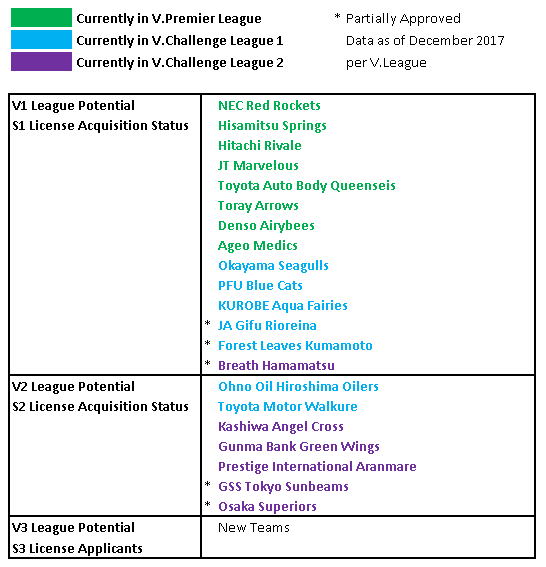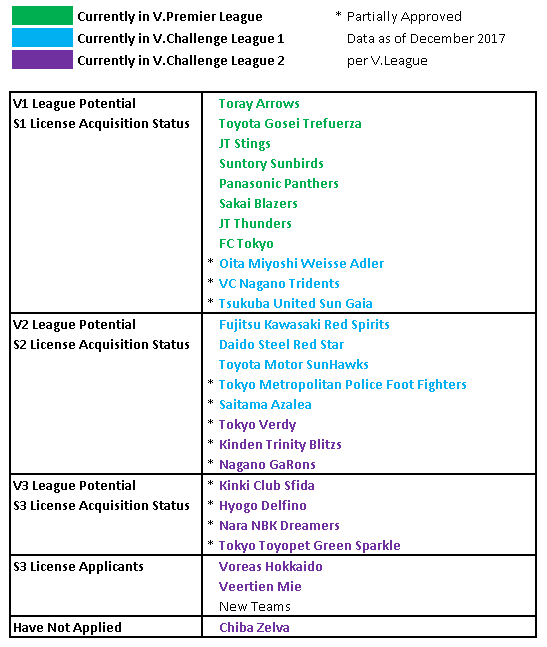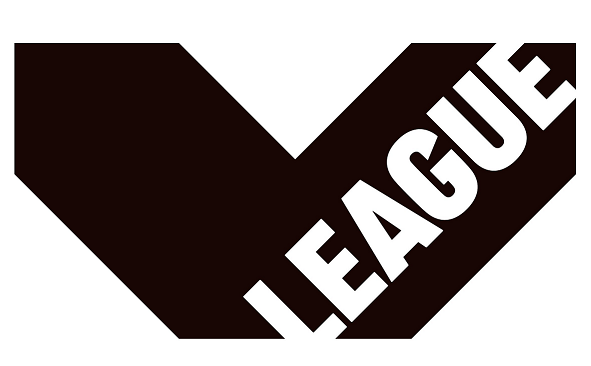With the Japanese V.League shifting to a license/franchise system for all teams in the league, the league also had set up standards for the different levels of the league for teams to meet.
The license system was the same for men and women’s league with the requirements for the different levels, V.LEAGUE 1 (V1, requiring a Superleague 1 (S1) license), V.LEAGUE2 (V2, requiring a Superleague 2 (S2) license) and V.LEAGUE 3 (V3, requiring a Superleague 3 (S3) license) .
A team looking to be in the V1 or V2 leagues would need to have the following:
- Team name with the city and/or business name in it
- A trademarked logo and team name
- Establishment of a junior team (for development)
- A practice arena (home arena can be used)
- Fan club
- Team mascot
- Minimum of 14 players registered (including foreign players)
The biggest difference between V1 and V2 teams would be the requirement a high level coach.
V3 teams would essentially have the same requirements as the V1 and V2 teams, however practice arenas, mascots and junior teams would not be required and a reduction in the minimum number of registered players to 12 from 14.
On Christmas Day, the V.League announced a preliminary list of which teams had met S1, S2 and S3 License levels. First we will list the women’s teams.


For the women’s V1 League, there will be a maximum of 12 teams for the 2018-2019 season, and at present there are 11 approved teams, with three still awaiting final approval, for a grand total of 14 potential teams. I would not hesitate in saying that the current eight teams in the V.Premier League will be in the V1 League next fall. Okayama, PFU and KUROBE are all in the top three in the V.Challenge League 1 by three wins or more over JA Gifu and Kumamoto at the halfway point in the season. I expect that those three will also make the V1 League. The remaining team will probably have to finish in fourth in V.Challenge League 1, in addition to meeting the license approval standard, which leaves Kumamoto and JA Gifu. Breath Hamamatsu at present are in V.Challenge League 2 and would therefore play in V2 in 2018-2019.
As for the women’s V2 League, five teams have already met the S2 licensing requirements, and then add in the two teams that would have S1 licenses. This would mean that V2 already has seven teams, and possibly two more teams in GSS Tokyo Sunbeams and Osaka Superiors who have to meet the S2 license approval standard.
Any new teams would be allocated to V3, but potentially elevated to V2 if there are not enough teams for a competition.
Now moving onto the men’s list of teams.


For the men’s V1 League, there will be a maximum of 10 teams for the 2018-2019 season, and at present there are eight approved teams (all currently in the V.Premier League), with three still awaiting final approval, for a grand total of 11 potential teams. I would not hesitate in saying that the current eight teams in the V.Premier League will be in the V1 League next fall. Nagano Tridents, Oita, and Tsukuba are 2nd, 3rd and 4th in the V.Challenge League 1 and I would guess that the top two of these three teams will be playing in V1, with the lowest finishing team in V2 in 2018-2019.
As for the men’s V2 League, three teams have already met the S2 licensing requirements, and then add in the one team that would have S1 licenses. This would mean that V2 already has four teams, and possibly five more teams in Tokyo Metropoliltan Police, Saitama, Tokyo Verdy, Kinden and Nagano GaRons who have to meet the S2 license approval standard.
There are enough men’s teams who have applied to also have a V3 League, with four teams with S3 partial license approval, and two more teams who have applied. Those two teams were expansion teams in the V.League this season, Voreas Hokkaido and Veertien Mie. Surprisingly, one team, Chiba Zelva did not put in an application for a license at any level. Chiba are in their third season in the V. Challenge League 2, so it strange that they did not apply when all other teams in both men’s and women’s league did apply.

Leave a Reply